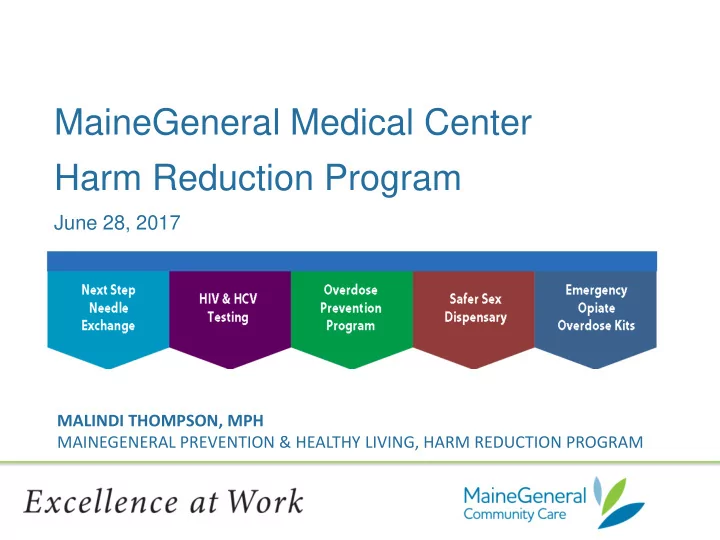

MaineGeneral Medical Center Harm Reduction Program June 28, 2017 MALINDI THOMPSON, MPH MAINEGENERAL PREVENTION & HEALTHY LIVING, HARM REDUCTION PROGRAM A new day.
Maine, 1997-2016 A new day.
MaineGeneral Medical Center’s ROOR project Law Enforcement trainings Community education Naloxone distribution in clinical settings Referral to Treatment A new day.
Referring People On-Scene Build upon partnerships Many options Create resources to help with delivery of materials A new day.
Referring People in a Clinical Setting Use data to inform Create systems Comprehensive medical staff training • SBIRT model & screening guidelines • Waiver training Involve champions A new day.
History of emergency care for intoxication or overdose. • • Just released from incarceration or institutionalization with history of opioid addiction. • History of substance abuse, regardless if currently abstinent. • Severe psychiatric illness or history of suicide attempt. • Prescribed long-acting opioid. High daily dose of opioid used (>50 mg morphine equivalent/day). • • Prescribed opiates or opioid use greater than 30 days. • History of or current polyopioid use. • Opioid use with certain concurrent diseases such as: renal dysfunction, liver disease, respiratory infection, sleep apnea, COPD, emphysema or other respiratory/airway disease that can lead to potential airway obstruction. • Concurrent prescription or OTC medication that could potentiate the CNS and respiratory depressant properties of opioid medications such as benzodiazepines, antipsychotics, carisoprodol or antihistamine use. • Patients who may have difficulty accessing emergency medical services (distance, remoteness, lack of transportation, homeless or without phone services). • Elderly (> 65) receiving an opioid prescription. • Youth under age 20 receiving an opioid prescription. • Households with people at risk of overdose, such as children or someone with a substance abuse disorder. If patient ask for a kit. • A new day.
Take-Aways Adapt & expand trainings Implement systems for screening & referring patients Involve key partners & champions A new day.
Recommend
More recommend